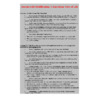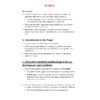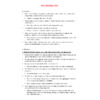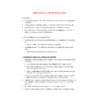|
|
Search Resources (73 Results)
 |
|
Outline | Approved: A year ago | 2.17 MB | Comments: 0
...found in some species enables the organisms...
...from dehydration. Some species may also have...
...present in many species of bacteria. Both...
...minutes from some species. This short generation...
...bacteria of different species. Recent outbreaks of...
...by bioremediation. Several species of bacteria can...
...inorganic compounds. Some species, such as Alcanivorax...
...of hundreds of species of bacteria &...
...individuals containing different species mixes. The primary...
...contributing to these species' success. The evolution...
...water, although protist species live in a...
...very large multicellular species, such as the...
...100,000 described living species of protists, &...
...how many undescribed species may exist. Since...
...relationships are often species-specific there is a...
...snow. Several protist species are parasites that...
...A few protist species live on dead...
...multinucleated; in some species, the nuclei are...
...other heterotrophic protist species ingest particles by...
...& many protist species can switch from...
...food crops. Plasmodium Species Members of the...
...the 4 Plasmodium species known to infect...
...highly aggressive mosquito species are crucial to...
...Latin America, another species in the genus,...
...the world’s aquatic species. Approximately ¼ of...
...organisms. Certain anaerobic species exist in the...
...chain. Without saprobic species, such as protists,...
...yeast) & Candida species (the agents of...
...to survive. Other species, such as the...
...in bioremediation. Some species of fungi can...
...aromatic hydrocarbons. Other species take up heavy...
...impacts on other species, including humans &...
...predation of nematodes. Species of Arthrobotrys fungi...
...of all plant species have mycorrhizal partners....
...Ascomycota or Basidiomycota species) living in close...
...The association between species of Basidiomycota &...
| N/A |
70
|
Amber Mason Turner
|
 |
|
Lecture Notes | Approved: 5 years ago | 69.15 kB | Comments: 0
...each of five species (A-E); fill in...
...values for each species. However: one species’...
...species. However: one species’ values are not...
...#s in each species Species A Species...
...in each species Species A Species B...
...species Species A Species B Species C...
...A Species B Species C Species D...
...B Species C Species D Species E...
...C Species D Species E N: 4...
...value for which species is not possible?...
...Explain why: For Species D, there is...
| 1
|
272
|
a123k456b789
|
 |
|
Lecture Notes | Approved: 6 years ago | 46.1 kB | Comments: 0
...the Origin of Species by Means of...
...that Earth’s many species are descendants of...
...descendants of ancestral species that were very...
...inhabited by unchanging species Darwin’s hypothesis had...
...evolution and viewed species as fixed and...
...with perfect, permanent species on every rung....
...creation held that species were individually designed...
...had designed each species for a purpose....
...system for naming species according to genus...
...to genus and species and classifying species...
...species and classifying species into a hierarchy...
...system, grouping similar species into increasingly general...
...Linnaeus, similarity between species did not imply...
...that destroyed the species then present. He...
...later repopulated by species immigrating from unaffected...
...fossils and current species, Lamarck found what...
...to a modern species. Lamarck explained his...
...different from modern species, more closely resembled...
...closely resembled modern species from South America...
...geographic distribution of species was further stimulated...
...of the animal species on the Galápagos...
...else, they resembled species living on the...
...origin of new species and the adaptation...
...the adaptation of species to their environment...
...Could a new species arise from an...
...among the 13 species of finches that...
...the origin of species and natural selection,...
...The Origin of Species and published it...
...The Origin of Species with immaculate logic...
...The Origin of Species had convinced most...
...The Origin of Species Darwin never used...
...The Origin of Species, although the final...
...trunk. Closely related species, the twigs on...
...Observation #2: All species are capable of...
...characteristic of all species. Only a tiny...
...considerable modification of species over hundreds of...
...rise to new species in the process....
...The Origin of Species, Darwin presented a...
...elegans), an introduced species from Asia. Soapberry...
...of the introduced species. Since the goldenrain...
...strains of this species, known as methicillin-resistant...
...own and other species The examples of...
...traits in related species have an underlying...
...For example, all species of life use...
...genes in related species may be fully...
...and that many species have become extinct....
...geographic distribution of species—biogeography, the geographic distribution...
...geographic distribution of species. The geographic distribution...
...generally have endemic species that are found...
...Earth. Most island species are closely related...
...closely related to species from the nearest...
...rise to new species as they adapt...
...by closely related species, but rather by...
...but rather by species that resemble those...
...know that new species can form in...
| N/A |
167
|
johaneswijaya
|
 |
|
Lecture Notes | Approved: 6 years ago | 31.52 kB | Comments: 0
Category: Botany | Downloaded: 0
...the Devonian, some species had evolved seeds....
...a single extant species, Ginkgo biloba. This...
...This popular ornamental species has fanlike leaves...
...straplike leaves. Gentum species are tropical trees...
...only about 550 species of conifers, a...
...conifers, a few species dominate vast forested...
...tree. 1) Most species produce both pollen...
...about 250,000 known species of angiosperms. 1....
...the monocots (65,000 species) or eudicots (165,000...
...or eudicots (165,000 species) several other clades...
...reproduction. In many species, insects and other...
...of another. Some species that occur in...
...colored in plant species that are pollinated...
...in wind-pollinated plant species. Neither the sepals...
...of the same species. The pollen grain...
...influence between two species is termed coevolution....
...cases, a plant species may be pollinated...
...such as diverse species of bees or...
...Conversely, a single species, such as a...
...as a honeybee species, may pollinate many...
...pollinate many plant species. D. Plants and...
...cultivating some plant species to provide a...
...is extinguishing plant species at an unprecedented...
...thousand of plants species and the animals...
...the loss of species is greatest in...
...250,000 known plant species. Almost all of...
...about two dozen species. We have derived...
...than 5,000 plant species as potential sources...
...most of these species by local people...
| N/A |
292
|
johaneswijaya
|
 |
|
Lecture Notes | Approved: 6 years ago | 30.36 kB | Comments: 0
...spores of most species are haploid, except...
...More than 100,000 species of fungi are...
...about 1.5 million species worldwide. Molecular analysis...
...conditions deteriorate, this species of Rhizopus reproduces...
...described over 60,000 species of ascomycetes, or...
...half the ascomycete species live with algae...
...asci. In many species, the spore-forming asci...
...(mushrooms in many species). The dikaryotic mycelia...
...given genus and species names, as though...
...organisms. Over 25,000 species have been described....
...the 100,000 known species of fungi are...
...about 50 fungal species are known to...
...infections of other species can cause tuberculosis-like...
| N/A |
155
|
johaneswijaya
|
 |
|
Lecture Notes | Approved: 6 years ago | 37.61 kB | Comments: 0
...million described extant species of animals. PARAZOA...
...3. About 9,000 species have been identified;...
...marine. About 100 species live in fresh...
...marine. About 10,000 species. 2. Radial symmetry...
...are about 20,000 species of flatworms living...
...member of a species is composed of...
...flame cells. Some species consist only of...
...called parthenogenesis. Other species produce two kinds...
...are about 5,000 species, mostly marine, and...
...are about 15 species only in two...
...more than 30,000 species of fossil brachiopods...
...about 300 extant species. PHYLUM NEMERTEA –...
...approximately 900 known species, most of that...
...freshwater and terrestrial species and some deep-water...
...and some deep-water species. They are acoelomate,...
...about 50,000 extant species, and about 35,000...
...about 35,000 fossil species. Bilateral symmetrical coelomate...
...fertilization external; many species pass through one...
...coiled in some species (torsion); pulmonate mantle...
...mantle in terrestrial species (pulmon: organ for...
...are about 15,000 species in the phylum....
...animals; about 10,000 species. Class Hirudinae. Mostly...
...and scavengers; some species adapted to humid...
...parasites. About 90,000 species. They play an...
...over a billion species found in all...
...About one million species have been described....
...use gills; terrestrial species have a system...
...are about 32,000 species of Crustaceans. They...
...are about 3,000 species of centipedes. They...
...and maxillae. 7,500 species of millipedes form...
...about 750,000 described species grouped into 26...
...fertilization; a few species hermaphroditic. Echinoderms are...
...and 13,000 extinct species make the phylum....
...the animal. One species has no gut......
...In the other species, there is a...
| N/A |
129
|
johaneswijaya
|
 |
|
Lecture Notes | Approved: 6 years ago | 48.2 kB | Comments: 0
...a million extant species of animals are...
...mainly of aquatic species. Most live in...
...of all animal species. Most of the...
...9,000 or so species of sponges range...
...marine. About 100 species live in fresh...
...over 10,000 living species, most of which...
...medusas of most species live among the...
...the approximately 100 species are marine. Some...
...are marine. Some species are spherical or...
...are about 20,000 species of flatworms living...
...include many parasitic species, such as the...
...hosts, and most species have complex life...
...with about 1,800 species, are tiny animals...
...of parthenogenesis. Other species produce two types...
...mosses. In most species, the colony is...
...all the 5,000 species of bryozoans are...
...animals, with several species that can be...
...are about 15 species of phoronids in...
...the 330 extant species of brachiopods are...
...richer past. 30,000 species of brachiopod fossils...
...more than 900 species are marine, but...
...but a few species inhabit fresh water...
...includes 150,000 known species of diverse forms,...
...more than 40,000 species in the Gastropoda...
...also many freshwater species. Garden snails and...
...somewhat flattened. Other species have lost their...
...plant material. Some species are predators. In...
...predators. In these species, the radula is...
...are about 15,000 species ranging in length...
...humans. Some parasitic species use blade-like jaws...
...are 90,000 described species, and perhaps ten...
...separate in most species and fertilization is...
...also include many species that are important...
...plant roots. Other species parasitize animals. Over...
...Over 50 nematode species, including various pinworms...
...a million arthropod species have been described...
...the criteria of species diversity, distribution, and...
...reduced in most species. Arthropods have evolved...
...exchange. Most aquatic species have gills with...
...Only four marine species, including the horseshoe...
...characteristic of each species. Silk fibers have...
...in defense. In species diversity, insects (class...
...time. In most species, sperm cells are...
...In a few species, females pick up...
...of the 40,000 species of crustaceans remain...
...cuticle, but larger species have gills. The...
...pore. Most aquatic species have several larval...
...with about 10,000 species, are one of...
...are small marine species, but they can...
...7,000 or so species of echinoderms are...
...their arms. Some species are suspension-feeders and...
| N/A |
122
|
johaneswijaya
|
 |
|
Lecture Notes | Approved: 6 years ago | 41.94 kB | Comments: 0
...(Atelopus varius), a species thought to be...
...the 82 known species of harlequin toads...
...of 2009, the species that Yeager found...
...interaction with other species such as pathogens...
...differences affect local species distribution. At any...
...occupied by different species of trees. A...
...distributions for individual species, they can predict...
...predict how that species distribution will change...
...question for tree species is whether seed...
...migration of the species as climate changes....
...pollen shows that species with winged seeds...
...plants and other species be able to...
...per year. Some species are already on...
...35 European butterfly species, including the silver-washed...
...for animals. The species composition of any...
...openings for new species in tropical and...
...that allow deciduous species, including aspen and...
...while many bird species migrate to warmer...
...and many fish species live in the...
...and threaten migratory species such as salmon....
...fish and invertebrate species and are crucial...
...areas for many species of waterfowl. An...
...the distribution of species. Species distributions are...
...distribution of species. Species distributions are a...
...hereditary in this species, the generation of...
...distributions of individual species in the context...
...distribution of any species. Ecologists ask where...
...Ecologists ask where species occur and why...
...occur and why species occur where they...
...the distribution of species. Ecologists focus on...
...and food availability. Species dispersal contributes to...
...geographic distribution of species. For example, cattle...
...of an ancestral species into new species...
...species into new species that fill many...
...intentionally transplanted a species to areas where...
...range of the species is larger than...
...other words, the species could live in...
...Ecologists rarely move species to new geographic...
...areas, because transplanted species may disrupt the...
...outcome when a species has been transplanted...
...distribution of many species. Female insects often...
...the distribution of species. In certain marine...
...biotic limitations on species distribution. Abiotic factors...
...not allow a species to survive and...
...and reproduce, the species will not be...
...important factor in species distribution. Intertidal species...
...species distribution. Intertidal species may face desiccation...
...typically contain few species. Salmon that migrate...
| N/A |
206
|
johaneswijaya
|
 |
|
Lecture Notes | Approved: 6 years ago | 36.43 kB | Comments: 2
Category: Botany | Downloaded: 0
...are about 720 species found in all...
...are about 235,000 species of flowering plants....
...two or more species act as selective...
...1.3 million living species of animals, and...
...number of animal species run far higher,...
...extant and extinct species. Some biologists estimate...
...99% of animal species are extinct. Some...
...most abundantly prey species thus reducing their...
...of a dominant species opens many niches,...
...become occupy by species previously excluded. Increase...
...Increase in prey species leads to an...
| N/A |
232
|
johaneswijaya
|
 |
|
Lecture Notes | Approved: 6 years ago | 34.06 kB | Comments: 0
Category: Botany | Downloaded: 0
...history of a species or group of...
...group of related species. A. The Fossil...
...well-preserved and widely-distributed species. By comparing different...
...substantial fraction of species that have lived...
...is slanted toward species that existed for...
...geographic distribution of species. For example, the...
...niches with new species. On a global...
...and the sea. Species that had evolved...
...the turnover of species was much more...
...escaped extinction. A species may become extinct...
...by some other species in its community...
...a majority of species have been swept...
...of all marine species. This event defines...
...of the marine species and many families...
...the loss of species, there are tremendous...
...and classification of species and groups of...
...and groups of species. As Darwin correctly...
...main characteristics. Each species has a two-part...
...a two-part name. Species are organized hierarchically...
...binomial system, each species is assigned a...
...to which a species belongs. The second...
...refers to one species within each genus....
...hierachical classification groups species into broader taxonomic...
...broader taxonomic categories. Species that appear to...
...an example, all species of cats are...
...name for various species of pine trees....
...of an ancestral species and all its...
...which similarities between species are relevant to...
...to grouping the species in a clade...
...parts that two species share, the more...
...an outgroup: a species or group of...
...or group of species that is closely...
...related to the species that we are...
...origin of the species that we are...
...example, a particular species in an old...
...than a second species that belongs to...
...cladograms to place species in the taxonomic...
...data for comparing species and tracing phylogenies...
...more recently two species have branched from...
...data for many species are available via...
...relationship between two species. This DNA sequence...
...the phylogeny of species that are closely...
...of the same species. The first step...
...sequences for the species we are comparing....
...Two closely related species may differ only...
...Less closely related species may not only...
...relationships among four species or taxa, we...
...group of 50 species. Even computer analyses...
...arrangement of four species, we would begin...
...for the four species, including the three...
...that for any species’ characters, hereditary fidelity...
...a set of species or higher taxa,...
| N/A |
189
|
johaneswijaya
|
|
Post your homework questions and get free online help from our incredible volunteers
1371 People Browsing
105 Signed Up Today
|